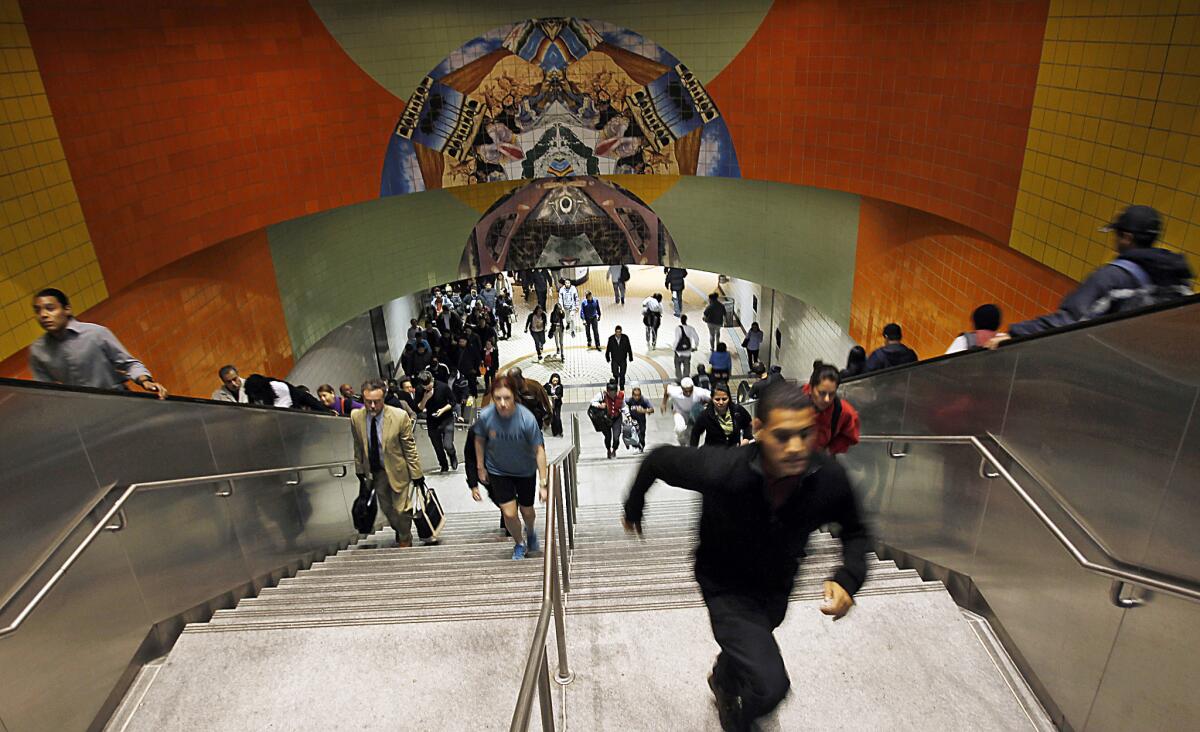California Commute: Lack of parking drives many away from mass transit

Los Angeles County has funneled billions of dollars over the last two decades into new rail lines to lure commuters out of their cars and off the region’s overcrowded freeways. But many would-be train riders are struggling with how to start.
One of the biggest barriers to attracting new riders to Metropolitan Transportation Authority trains is not the price of fares or the frequency of service. It’s the lack of parking.
Half of Metro’s 80 rail stations have no parking. And at the stops where there are spaces, riders frequently complain that there aren’t nearly enough. In North Hollywood, where the Red Line subway ends, the MTA estimates that it loses as many as 1,500 riders a day because the parking lot fills up by 7:30 a.m.
“Today I got lucky,” said Ashley Scott, 30, as she waited for her train to Hollywood on a recent Thursday morning. “I was this close to just getting on the 101.”
Scott’s daily dilemma illustrates an often overlooked but significant choke point in the ambitious growth of L.A.’s light-rail system. Metro’s six-line network, which has seen steady ridership gains over the last five years, now carries about 350,000 people on work days. Parking shortages could complicate Metro’s goal of shifting hundreds of thousands more drivers to public transit in coming decades.
Planners say it’s impractical, perhaps impossible, to build enough free parking. Train station lots have low turnover because most commuters leave their cars all day. To meet demand, Metro lots would have to sprawl far beyond the station—or, in dense urban areas, rise several stories.
Studies from several U.S. cities show a direct link between parking and ridership, suggesting that full lots discourage some people from riding the train. But limited land availability and high construction costs constrict Metro’s ability to add spaces.
Metro plans to add 200 parking spaces along Chandler Boulevard to the tune of $1.4 million. After the cost of the land and labor, a typical one-acre asphalt lot with about 120 spaces costs between $500,000 and $750,000. A parking structure for that number of cars would cost several million dollars.
Northern California’s Bay Area Rapid Transit system faces similar questions. A recent study there estimated a dozen new above-ground parking garages in Oakland, Berkeley and nearby suburbs would cost nearly $250 million to build—about $36,000 per space.
The parking dilemma also raises a key policy question: Should a transit agency ever encourage people to drive to stations?
“We’ve got to consider it, just because of how big and spread out we are,” said Martha Welborn, Metro’s chief planning officer.
Southern California’s infamous sprawl makes reaching rail by foot, bike or bus more complicated, or at least more time-consuming, than in other cities. Achieving the same train connectivity as a compact East Coast city, she said, would require at least three times as many miles of tracks.
In Los Angeles County, Metro has five new rail lines under construction. Only some suburban stations will have parking, and planners acknowledge that those spaces will fill up quickly.
Some relief from the parking crunch could come from private development deals. In North Hollywood, Metro hopes to attract a mixed-use development on the existing lot, with shops, apartments and a new parking structure, all financed by a private builder, said Paul Krekorian, a Metro board member and Los Angeles city councilman whose district includes the station.
Donald Shoup, a UCLA urban planning professor who studies parking, said Metro should consider a flexible pricing system that would charge drivers based on space availability; when the lot is fuller, it becomes more expensive to park. That system, he said, would encourage turnover and reduce demand.
“We pay for our tires, and our insurance, and our repairs, but when it comes to parking, people somehow think that it has to be free,” he said.
But some fear that charging for parking could scare some commuters away. “Our objective is not to make money on parking; our objective is to get people to ride the system,” said Calvin Hollis, a Metro managing executive officer.
In the long term, if ridership is to continue to grow, particularly in the suburbs, commuters’ habits will have to change, Shoup says. Metro officials say they are trying to encourage alternatives modes of getting to stations, including adding more bike racks and adjusting bus routes to complement rail lines.
But getting more people to ride the bus to the train, for example, presents its own challenges. In the Valley, if more commuters park along the Orange Line busway and take that to the subway, Metro will have to add more buses, Krekorian said. The line handles more than 30,000 boardings a day, and peak-hour buses are often standing-room only.
The California Commute columnists Laura J. Nelson and Dan Weikel are looking for leads. Send them ideas, gripes and questions.
For more transportation news, follow @laura_nelson on Twitter.
More to Read
Sign up for Essential California
The most important California stories and recommendations in your inbox every morning.
You may occasionally receive promotional content from the Los Angeles Times.











